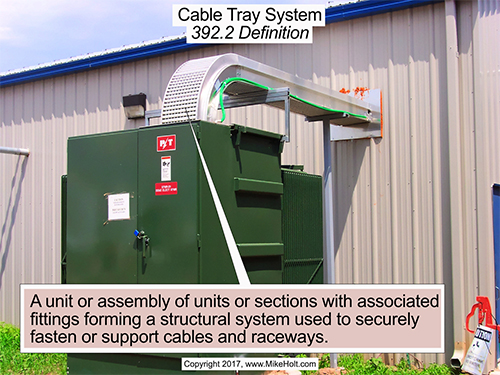|
For EC&M Magazine
By Mike Holt, NEC® Consultant
Here's the follow-up to yesterday's newsletter.
This includes the answers to the questions sent, so you can see how you did.

(6).jpg)
Figure 01
|
 |
|
Figure 01
|
For EC&M Magazine
By Mike Holt, NEC® Consultant
Here's the follow-up to yesterday's newsletter.
This includes the answers to the questions sent, so you can see how you did.

Note: The answers to these questions are based on the 2017 NEC.
Q1. How does the NEC define a Cable Tray System?
A1. A cable tray system is a unit or assembly of units or sections with associated fittings forming a rigid structural system used to securely fasten or support cables, raceways, and boxes [392.2]. Figure 01
Author’s Comment:
- Cable tray isn’t a type of raceway. It’s a support system for cables and raceways.
Q2. What are the Code permitted uses of a Cable tray?
A2. Cable trays can be used as a support system for service, feeder, or branch-circuit conductors, as well as communications circuits, control circuits, and signaling circuits [392.10]. Cable tray installations aren’t limited to industrial establishments. If exposed to the direct rays of the sun, insulated conductors and jacketed cables must be identified as being sunlight resistant. The manufacturer must identify cable trays and associated fittings for their intended use.
Author’s Comment:
- Cable trays used to support service-entrance conductors must contain only service-entrance conductors unless a solid fixed barrier separates the service-entrance conductors from other conductors [230.44].
Q3. What wiring methods does the NEC allow to be installed in a cable tray?
A3. Any wiring methods listed in Table 392.10(A) can be installed in a cable tray [392.10(A)].
Author’s Comment:
- Control, signal, and communications cables must be separated from the power conductors by a barrier or maintain a 2-in. separation.
- Coaxial Cables, 820.133(A)(1)(b) Ex 1
- Class 2 and 3 Cables, 725.136(B) and 725.136(I)
- Communications Cables, 800.133(A)(2) Ex 1
- Fire Alarm Cables, 760.136(G)
- Optical Fiber Cables, 770.133(B)
- Intrinsically Safe Systems Cables, 504.30(A)(2) Ex 1
- Radio and Television Cables, 810.18(B) Ex 1
Table 392.10(A) Wiring Methods |
Wiring Method |
Article/Section |
Armored cable |
320 |
Coaxial cables |
820 |
Class 2 & 3 cables |
725 |
Communications cables |
800 |
Communications raceways |
725, 770, and 800 |
Electrical metallic tubing |
358 |
Electrical nonmetallic tubing |
362 |
Fire alarm cables |
760 |
Flexible metal conduit |
348 |
Instrumentation tray cable |
727 |
Intermediate metal conduit |
342 |
Liquidtight flexible metal conduit |
350 |
Liquidtight flexible nonmetallic conduit |
356 |
Metal-clad cable |
330 |
Nonmetallic-sheathed cable |
334 |
Nonpower-limited fire alarm cable |
760 |
Polyvinyl chloride (PVC) conduit |
352 |
Power and control tray cable |
336 |
Power-limited fire alarm cable |
760 |
Power-limited tray cable |
Table 725.154 and 725.179(E) and 725.71(F) |
Rigid metal conduit |
344 |
Service-entrance cable |
338 |
Signaling raceway |
725 |
Underground feeder and branch-circuit cable |
340 |
For uses permitted in industrial establishments [392.10(B):
Where conditions of maintenance and supervision ensure that only qualified persons service the installed cable tray system, single-conductor cables can be installed if:
- 1/0 AWG and larger listed and marked for use in cable trays [392.10(B)(1)(a)].
- Equipment grounding conductors must be 4 AWG and larger [392.10(B)(1)(c)].
Cable trays in hazardous locations must contain only the cable types and raceways permitted by the Code for the application [392.10(C)].
Author’s Comment:
- For permitted cable types, see 501.10, 502.10, 503.10, 504.20, and 505.15.
In addition to the uses permitted elsewhere in Article 392, nonmetallic cable trays can be installed in corrosive areas, and in areas requiring voltage isolation [392.10(D)].
Q4. What uses of cable trays are not permitted by the NEC?
A4. Cable tray systems aren’t permitted in hoistways, or where subject to severe physical damage [392.12].
Q5. What is the NEC rule regarding the continuity of cable tray systems and their accessibility?
A5. Cable trays must be installed as a complete system, except mechanically discontinuous segments between cable tray runs, or between cable tray runs and equipment are permitted. The system must provide for the support of the cables and raceways in accordance with their corresponding articles [392.18].
A bonding jumper, sized in accordance with 250.102 and installed in accordance with 250.96, must bond the sections of metal cable tray, or the cable tray and the raceway or equipment.
Each run of cable tray must be completed before the installation of cables or conductors [392.18(B)].
Cable trays can extend through partitions and walls, or vertically through platforms and floors if the installation is made in accordance with the firestopping requirements of 300.21 [392.18(D)].
Cable trays must be exposed and accessible, except as permitted by 392.18(D) [392.18(E)].
Sufficient space must be provided and maintained about cable trays to permit adequate access for installing and maintaining the cables [392.18(F)].
|

